In November 2022, ChatGPT 3.5 came out, and the Business World changed its perception of what's important, what's coming next, and what companies need to focus on right now to succeed in the future with AI (Artificial Intelligence).
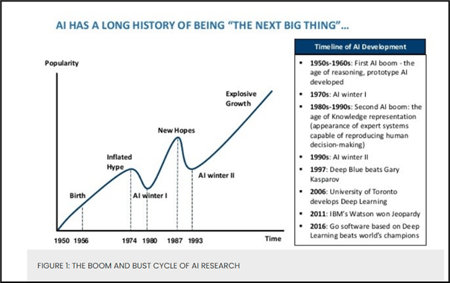 GPT stands for Generative Pre-trained Transformers (more on that later). Ok, we've heard this before, and this has been coming since they built all the math in the 1950s for it until the first AI Winter in 1980 (some algorithm math goes back to the 1800s). Next, it was coming again until the next AI Winter in 1993. Now it's coming again, and they actually have the hardware to power it (clouds that can deliver the performance needed, including Oracle's) and actual proof that it's really possible & useful this time (ChatGPT - words, DALL-E - images, Bard...etc).
GPT stands for Generative Pre-trained Transformers (more on that later). Ok, we've heard this before, and this has been coming since they built all the math in the 1950s for it until the first AI Winter in 1980 (some algorithm math goes back to the 1800s). Next, it was coming again until the next AI Winter in 1993. Now it's coming again, and they actually have the hardware to power it (clouds that can deliver the performance needed, including Oracle's) and actual proof that it's really possible & useful this time (ChatGPT - words, DALL-E - images, Bard...etc).
Note the diagram on the history of AI is right from actuaries.digital (actuaries seem to be best at predicting stuff). Now it's not just AI coming, but Generative AI, which can even create new content (Hallucinations - or Errors as well - be careful). Of course, some say hallucinations in Large Language Models (LLMs) like ChatGPT are ok since people are often wrong when they create something new, and it helps the innovation process; nice try, but when I ask for facts, I actually expect them to be facts, not hallucinations. That said, I think it can help innovation as well.
"I do think we are the beginning of AI truly taking off"
I do think we are the beginning of AI truly taking off, thanks to all the math creation over the past 100 years, the first version failing without hardware to support it over the past 50 years, and the algorithms being tested over the past 20 years as Data Scientists leveraged Machine Learning for early adopters.
Finally, the Transformer paper by Google has been publicly tested by OpenAI & Microsoft over the past 5 years with exponentially greater amounts of data being trained (note that one of the authors of the Google Transformer paper is Aidan Gomez, founder of Cohere, one of Oracle's key AI partners that leverages Oracle's new Vector Database).
Finally, putting a chat front end to the best LLM model made by OpenAI, GPT 3 (deep neural network model with 175 Billion ML Parameters) & GPT 4 (deep neural network model with 100 Trillion ML Parameters), is making the current Tech AI growth trend the biggest hit for tech in a long time starting with ChaptGPT 3.5 which came out November 30, 2022 (and GPT-4 on March 14, 2023). Note that GPT-1 had only 117M parameters & GPT-2 had only 1.5B. Moore's law does not apply, we're moving a lot faster now!
Is Generative AI (GenAI) ready for prime time? I like Larry's answer at last year's Cloud World: "You're about to find out."
Larry was noting the countless billions spent so far on AI. I'm not sure GenAI is fully ready for production, but I do believe it will get there quickly with the unbelievable amount of money that's being poured into the market, driving many early adopters. Most companies are investing in both preparing data & gaining insights from their data than ever before while gently looking for the AI tool that truly provides growth in their unique market and gives a Return on Investment (ROI). It's important to note that key decision-makers must come to the table to truly leverage AI, as they are the ones who understand their unique business & competitive advantage.
Is Oracle ready for prime time with GenAI?
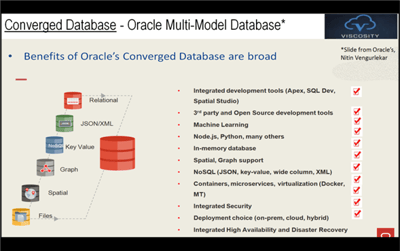 With Oracle's lead in data security, manageability, availability, recoverability, and the Autonomous Database to quickly spin up data lakes, data warehouses, and other data sources that are self-managing, they check the all-important #1 Leader in Data box. Oracle has a decades-long investment in the Database that few will ever catch and a strong Data Analytics tools practice (20+ years) with excellent Data Mining Tools created over the past 30 years, investments in both Machine Learning (ML) and AI in the past 10-15 years (with integration to their data mining tools and extensive machine learning algorithms - they are all FREE with the Database). Oracle is in the Magic Quadrant in Cloud (recently), Analytics, and, to some degree, fully ready with Machine Learning. But now, with the Vector Database, Oracle can play with the AI leaders by using Cohere, OpenAI (ChatGPT), and others as partners.
With Oracle's lead in data security, manageability, availability, recoverability, and the Autonomous Database to quickly spin up data lakes, data warehouses, and other data sources that are self-managing, they check the all-important #1 Leader in Data box. Oracle has a decades-long investment in the Database that few will ever catch and a strong Data Analytics tools practice (20+ years) with excellent Data Mining Tools created over the past 30 years, investments in both Machine Learning (ML) and AI in the past 10-15 years (with integration to their data mining tools and extensive machine learning algorithms - they are all FREE with the Database). Oracle is in the Magic Quadrant in Cloud (recently), Analytics, and, to some degree, fully ready with Machine Learning. But now, with the Vector Database, Oracle can play with the AI leaders by using Cohere, OpenAI (ChatGPT), and others as partners.
With the Vector Database (covered below), Oracle now covers a space where your investment in the Oracle database can pay dividends. Instead of buying 5 different types of Databases with questionable security, availability & recoverability, you leverage the best AI tools with the Oracle database (see image with all of Oracle's free options with their converged Database). Add the FREE front-end tool (APEX) & you've really fully got the benefits of Oracle and your developers & DBAs who know it well.
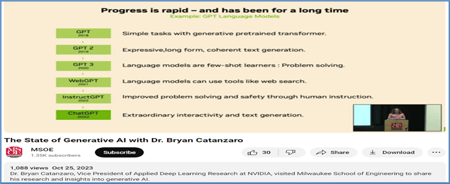 Few people paid attention to the release of GPT-1 or GPT-2 (according to an NVIDIA guy). Everything accelerated with the very public release of ChatGPT - 3.5 (170 Billion Parameters) on November 30, 2022, leveraging the internet and other data as of September 2021. An LLM that is basically using machine learning models that leverage Transformers (along with the other math built a long time ago) to search the internet for detailed answers to complex questions. For example, "build me a machine learning model and a ChatBot that competes with ChatGPT." Another example would be to write a story that starts with "Once upon a time ..." (add anything you want here, and it will do the rest). It's using the LLM (leveraging Transformers) to find the next word in the story for you, then find the word after that (using the word it just predicted), and so on. GenAI (Generative AI) helps you find information or predict "what's coming next." Now, companies can predict what's coming next for their own company. Less than 4 months later, GPT-4 (100 Trillion Parameters) came out as an improvement and is currently being used by many companies. It includes images as well as words. GPT-4 is multimodal (text, images, and voice).
Few people paid attention to the release of GPT-1 or GPT-2 (according to an NVIDIA guy). Everything accelerated with the very public release of ChatGPT - 3.5 (170 Billion Parameters) on November 30, 2022, leveraging the internet and other data as of September 2021. An LLM that is basically using machine learning models that leverage Transformers (along with the other math built a long time ago) to search the internet for detailed answers to complex questions. For example, "build me a machine learning model and a ChatBot that competes with ChatGPT." Another example would be to write a story that starts with "Once upon a time ..." (add anything you want here, and it will do the rest). It's using the LLM (leveraging Transformers) to find the next word in the story for you, then find the word after that (using the word it just predicted), and so on. GenAI (Generative AI) helps you find information or predict "what's coming next." Now, companies can predict what's coming next for their own company. Less than 4 months later, GPT-4 (100 Trillion Parameters) came out as an improvement and is currently being used by many companies. It includes images as well as words. GPT-4 is multimodal (text, images, and voice).
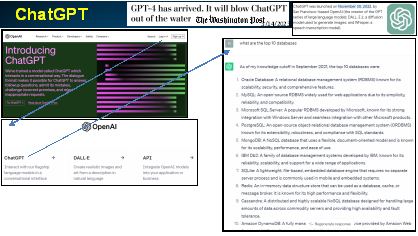 Now Google, who wrote the original paper on transformers, got left a step behind with a technology they played "the" key part in accelerating for prime time with the transformers paper (of course, Google had been working on many products - some were released - but, Bard hadn't been released yet). What transformers did was tremendously outperform what people were using to leverage Machine Learning with words previously (Recurrent Neural Networks - a few others - GRU/LSTM) and made it so your story above, built with GenAI, could be 1000+ pages long instead of 50 words long (the old models didn't have long term memory, basically). Google, not to be outdone (almost ever in this area), only recently released Bard (a competing ChatBot), which they had been working on and not releasing for different reasons now evident in ChatGPT (some of the errors or hallucinations). Very recently, Google released Gemini (a family of multimodal LLMs as successors to LaMDA & PaLM2). I've used both ChatGPT & BARD, and they are both something worth using as long as you take into account potential hallucinations.
Now Google, who wrote the original paper on transformers, got left a step behind with a technology they played "the" key part in accelerating for prime time with the transformers paper (of course, Google had been working on many products - some were released - but, Bard hadn't been released yet). What transformers did was tremendously outperform what people were using to leverage Machine Learning with words previously (Recurrent Neural Networks - a few others - GRU/LSTM) and made it so your story above, built with GenAI, could be 1000+ pages long instead of 50 words long (the old models didn't have long term memory, basically). Google, not to be outdone (almost ever in this area), only recently released Bard (a competing ChatBot), which they had been working on and not releasing for different reasons now evident in ChatGPT (some of the errors or hallucinations). Very recently, Google released Gemini (a family of multimodal LLMs as successors to LaMDA & PaLM2). I've used both ChatGPT & BARD, and they are both something worth using as long as you take into account potential hallucinations.
 The best way to minimize hallucinations in noisy data in your Business application is to have factual data of your own to leverage, something called Retrieval Augmented Generation (RAG). Cohere is one of the experts with, arguably, the leading-edge product in this area.
The best way to minimize hallucinations in noisy data in your Business application is to have factual data of your own to leverage, something called Retrieval Augmented Generation (RAG). Cohere is one of the experts with, arguably, the leading-edge product in this area.
Stay tuned for Part II where we dive deeper into Oracle's partnership with Cohere and explore the future of querying data, images, and beyond with GenAI.
References:
- DBAs Next Great Job (presentation), Rich Niemiec
- Larry Ellison Keynote at CloudWorld 2023
- Juan Loaza Keynote at CloudWorld 2023
- Oracle 23c; Oracle CloudWorld, Andrew Mendelsohn
- Preparing for Oracle 23c, Rich Niemiec
- Oracle12c Release 2 Performance Tuning Tips & Techniques; Richard J. Niemiec; Oracle Press
- The Economic Potential of GenAI, McKinsey (from Oracle presentation)
- viscosityna.com, www.oracle.com, & technet.oracle.com
- The State of Generative AI with Dr. Bryan Catanzaro, YouTube
- All companies and product names are trademarks or registered trademarks of the respective owners
- Rich Niemiec ©2023. This document cannot be reproduced without expressed written consent from Rich Niemiec or Viscosity NA but may be reproduced or copied for article, presentation, and conference use by the author.
- Neither Viscosity nor the author guarantees this document to be error-free. Please provide comments/questions to richniemiec@gmail.com – niemiec@viscosityna.com; I am always looking to improve!

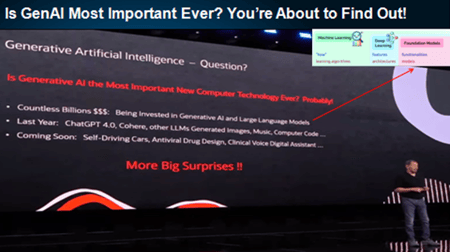
-3.png)


SUBMIT YOUR COMMENT